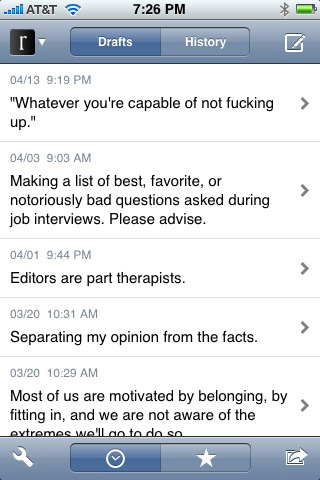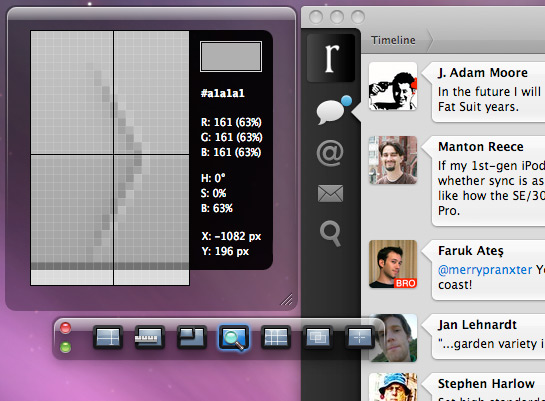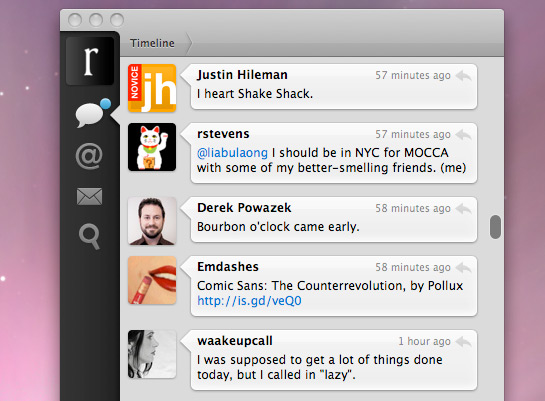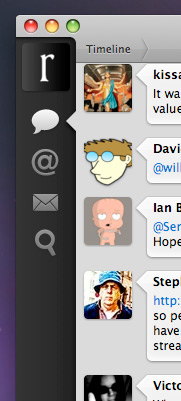Big couple of weeks for Twitter. Biz was on Colbert. Ashton got a million followers and bought a bunch of mosquito nets. Oprah showed up sans shift key. Twitter seems to be on the front page of everything but, curiously, has done nothing functionally interesting. They’re just sitting there keeping the lights on.
Not everyone is just sitting there. Some are wondering, “What’s next?”
Birdhouse (Adam Lisagor and Cameron Hunt)
The best explanation (and compliment) I can give Birdhouse is that it’s just like Twitter — the more I attempt to explain what it is, the less you’ll understand. You’re not really going to get it until you use it, but here goes…
Before I begin, a quick reminder. My opinion regarding tweets can be summarized thusly: “I don’t give a fuck what you had for lunch unless you give me reason.” This colorful opinion has already been well documented in The Art of the Tweet.
Described by its creators as “A Notepad for Twitter”, Birdhouse is precisely the application you should be using if you want to bring some art to your tweets.
Let’s say that art is one part consideration and one part timing. Birdhouse supports both parts by providing a temporary safe haven for your partially formed thoughts.
I’ve got an approximate tweet rate of six tweets per day. That’s my thing. The rate at which I discover tweets varies as a function of time and caffeination, but almost always exceeds the publishing rate, which means I’ve often got a tweet pile-up somewhere. Birdhouse is a perfect place to park a thought or link.

While Birdhouse has a clean, usable interface, it’s the act of parking an idea that’s where the innovation lies. Birdhouse separates the act of creation from the act of publication. It replaces the unnecessary rush between “I just thought of this” and “I need to publish this” with calm consideration. This replacement, in my opinion, is essential to developing tweet content of value.
Try it. I know your quip tastes mentally delicious when it shows up, but is now the precise time to share it? Maybe it needs the larger Monday morning audience? Maybe you’ve already unleashed enough of the funny for that day? Your Twitter-schtick is your deal, but my belief is an idea gets better both by letting it ferment as well choosing the right time to open it.
When I first heard of Tweetie for iPhone, I sighed. The problem with explaining Twitter to the uninitiated is, well, you have to say Twitter. A lot. Then you end up saying “tweet” or “twittersphere” or “twoot” and then you flash back to the embarrassing conversation with your Mom when you tried to explain what a blog was.
“No no no Mom… it’s an important thing.”
“What is?”
Sigh. “A blog.”
Tweetie takes dorky, uncomfortable names to the next level. And it does so with stunning visuals and clean interaction design that will change how you use Twitter on your desktop. I mean it.
My measure for compelling visual design is, after installation, whether or not, in the first five minutes, I fire up xScope to see the pixel-by-pixel construction of a particular piece of UI. Exactly 12 seconds after I fired up Tweetie, I was applying the microscope to the breadcrumb bar in Tweetie because I wanted to know “How’d he build that?”

Build products that speak for themselves. It’s simple. The teaser video for Tweetie had no feature lists, it had no spin; it was a simple, kickin’ video with nouns and verbs where using the product was the best pitch. Take a look at the application window below and tell me how many words you can find that describe the functionality. I count one. How many do you count here?

The rest of the real estate is an elegant distillation of the four most important Twitter features:
- Updates — who said what?
- Mention — did they say it about me? to me?
- Direct Messages — only me?
- Search — if they’re not talking about me, what they hell are they talking about?
Twitter has been tidying up the layout of the site to focus on these features, but I don’t want to visit the website — that’s why I installed a rich client. After two weeks of regular usage, Tweetie has eliminated my daily visits to the website by providing simple access to all of the features I need and it does so by borrowing from the future.
 Tweetie is a desktop version of an application of the same name for the iPhone which, in my limited experience, is the first time an application has migrated from the phone to the desktop. As a friend mentioned, “Platform merge in progress!” and he’s right.
Tweetie is a desktop version of an application of the same name for the iPhone which, in my limited experience, is the first time an application has migrated from the phone to the desktop. As a friend mentioned, “Platform merge in progress!” and he’s right.
The navigation in the desktop version of Tweetie feels… like the iPhone. Jumping from Updates to Mentions (via the essential and deliciously obvious keyboard shortcuts) feels like a flick of your index finger. Drilling down on an avatar accesses the user information with a clean horizontal scroll, again, inspired by iPhone navigation.
It’s delightful to navigate Tweetie. The application seamlessly integrates Twitter users, their information, and their conversations into a mesh of information that feels like more than the sum of their parts. And I believe Tweetie, like Twitter, is just getting started. Quick, look at the Tweetie interface and tell me exactly where a future Groups feature lands.
When I use Tweetie, I’m reminded that a maniacal attention to detail not only makes you want to reach out and touch the digitally untouchable, it describes the familiar as the new, and, most importantly, it speaks of an aspirational future.
10 Responses